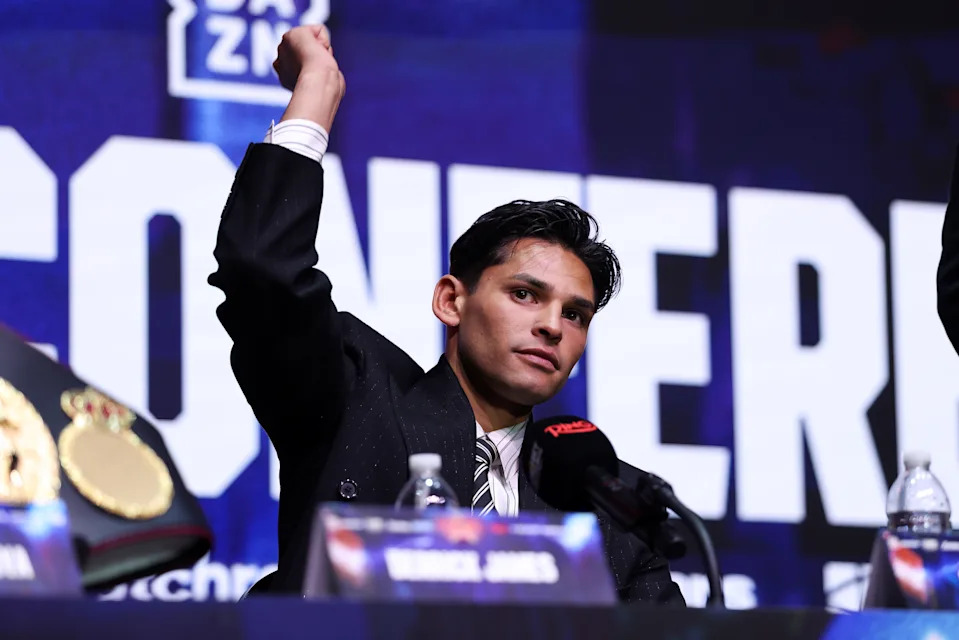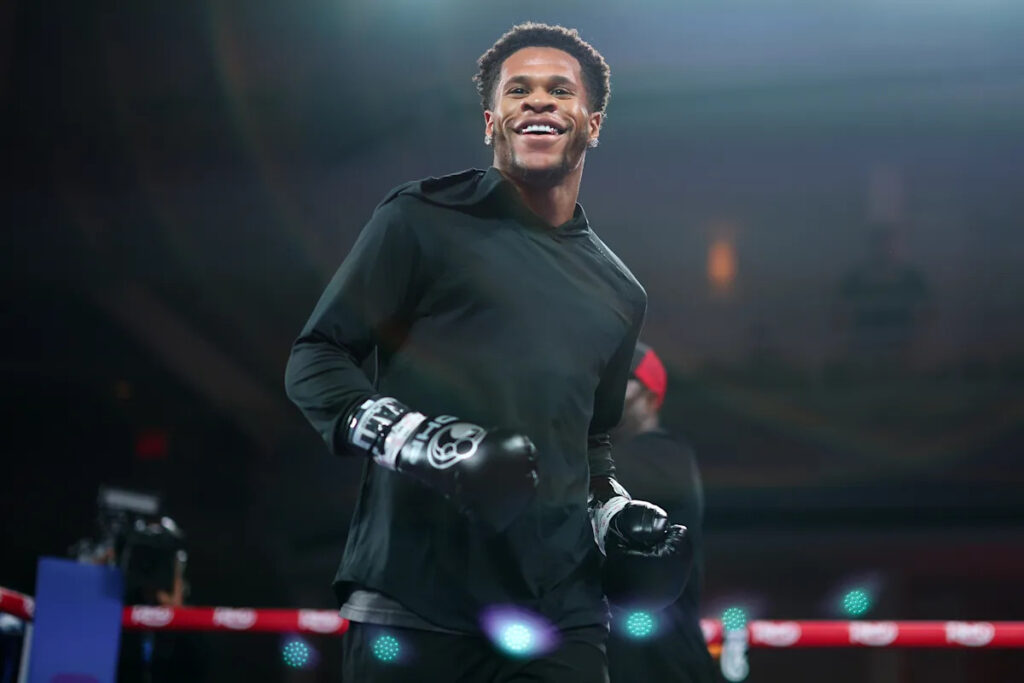Devin Haney is hardly the first boxer to lean into the villain role.
It’s not the path he chose, but he’s opted to play the hand he was dealt. That was on full display during an open workout Tuesday, when Haney (31-0, 1 NC 15 KOs) raced to the corner of the ring, mounted the ropes and reveled in the boos wafting his direction.
Advertisement
The undefeated former two-division champion has grown accustomed to his place among boxing’s most despised. A he admitted at the start of the press tour ahead of this weekend’s DAZN Pay-Per-View from Times Square in New York: “It’s easier to play the villain. … It pays better.”
The obvious question is how does an unbeaten, well-mannered boxer who is among the best in the sport and a proven clean athlete find himself in such a position?
Weirdly, it was a role forced upon him in the aftermath of his clash with Ryan Garcia last April at Barclays Center in New York.
Garcia (24-1, 20 KOs) initially claimed a majority decision win, which was changed to a no-contest after Garcia tested positive for ostarine in testing contracted through Voluntary Anti-Doping Association.
Advertisement
A separate test from a sample collected by the New York State Athletic Commission (NYSAC) also revealed the presence of the same banned substance.
Devin Haney was welcomed by boos during a media workout ahead of Friday’s welterweight bout against Jose Ramirez. (Photo by Cris Esqueda/Golden Boy/Getty Images)
(Cris Esqueda/Golden Boy via Getty Images)
The incident in question capped a months-long stretch of outrageous behavior exhibited by Garcia throughout the buildup to their fight. After weeks of putting the event in jeopardy, Garcia then showed up to the official pre-fight weigh-in more than three pounds over the 140-pound limit, which meant Haney’s WBC junior welterweight title was no longer at stake.
An investigation conducted by the NYSAC surrounding the positive drug tests resulted in a one-year suspension for Garcia, plus the maximum allowable $10,000 fine and the complete forfeiture of his reported $1,200,000 fight purse. Those terms were part of a legal settlement reached with Garcia, but the punishment didn’t placate Haney.
Advertisement
“It means nothing if a proven cheater can just get a one-year ban,” Haney previously told Uncrowned.
Worse, Garcia has emerged as the far more celebrated figure. His status only grew after Haney filed a lawsuit alleging fraud, battery and breach of contract. After filing the suit, Haney was ridiculed by Garcia, his legion of fans and even Hall of Fame boxer turned promoter Oscar De La Hoya, whose Golden Boy Promotions represents Garcia.
Now Garcia will face Rolando Romero (16-2, 13 KOs) in a secondary WBA welterweight title fight atop the four-fight PPV event. Haney is relegated to the co-feature slot, where he meets fellow former champ Jose Ramirez. The bout is contracted for 144 pounds, which technically marks the welterweight debut for both boxers.
The event is designed to lead to a Garcia-Haney rematch later this year, likely to take place in Riyadh, Saudi Arabia. The location is in play because of Turki Alalshikh, the driving force behind Riyadh Season’s emergence in boxing who is financing this weekend’s Times Square event.
Advertisement
In fact, Garcia never even bothered to comply with at least one key term of the settlement with NYSAC — random drug testing throughout his suspension — until he joined forces with Alalshikh. One staple of Riyadh Season events is its consistent use of VADA testing for all involved fighters.
Garcia agreed, but also made a point to double up and enroll in testing as conducted through the California State Athletic Commission. It proved to be his wisest move, as it helped satisfy the terms required by NYSAC to be removed from suspension.
Still, Garcia remains critical of an agency most others consider to be the gold standard of drug testing in the sport.
Advertisement
He’s previously claimed to be the victim of a conspiracy, given Haney’s close relationship with SNAC founder Victor Conte, who also founded the infamous BALCO organization implicated in a 2005 steroid scandal that resulted in a brief prison sentence for Conte. Conte served as an adviser in the early formation of VADA, and remains a vocal supporter of the program.
There were also claims of contamination from a supplement Garcia reportedly used during training camp. His team ordered testing on an opened container of the supplement, and the results showed trace amounts of the same banned substance found in Garcia’s system.
For many boxing fans, this was all the excuse they needed to exonerate Garcia in the court of public opinion. They’ve yet to warm up to anything Haney has to say, however, despite the fact the 26-year-old is enrolled in year-round testing.
“The importance of being a 365 athlete is to show that we’re clean no matter the circumstance,” Bill Haney, Devin’s father, trainer and manager told Uncrowned. “We’re not cycling and just waiting for a fight to get signed to begin testing. We are here to be the gold standard of boxing.
Advertisement
“Floyd Mayweather came along and changed the way things are done in this sport. That became the Floyd era. It’s important for what we call ‘The Devin Haney Era,’ whether you like it or not. During a time when everyone was talking about sides of the street, we were the ones that worked with everyone to get all of the fights we wanted and prove that we’re clean while doing it.”
But highlighting their focus on doing things the right way has fueled a faction of the sport that loves to hate the Haneys. Those same fans continue to blindly support Garcia, no matter the evidence against him.
The lawsuit undoubtedly provided more harm than good in terms of public opinion. Garcia added fuel to the fire by mocking Haney’s claim he was assaulted in a boxing ring.

Ryan Garcia has become a fan favorite in spite of, or maybe because of, his record of very public controversies. (Photo by Cris Esqueda/Golden Boy/Getty Images)
(Cris Esqueda/Golden Boy via Getty Images)
“I’m being sued for doing my job,” Garcia said at the time in a social-media post to his more than 12 million followers on Instagram. “This fight has been a Netflix documentary, but this right here is the finale. Your honor, he simply struggles with left hook syndrome.”
Advertisement
While the no-contest result allowed Haney to keep his WBC 140-pound belt (which he subsequently vacated) and his unbeaten record, he was dropped from pound-for-pound lists. He continues to field criticism for his perceived lack of adjustments in the fight, particularly against Garcia’s left hook, which was the primary weapon in Haney’s three trips to the canvas.
An alternate theory is offered by the other side of that equation.
“You ask why Devin can’t block a left hook,” Bill Haney said. “We reply that Ryan’s power was a direct result of the drugs, of the ostarine. Ryan was a mental patient, he was on drugs, on steroids, drinking. He lied repeatedly to everyone, including his own followers … and he’s somehow the f*****g hero in all this.
“Now all of a sudden, he’s perfectly sane? If you lie to us once, it’s shame on you. If you lie to us again and we fall for it, then shame on us. So we don’t believe anything that he’s saying now. The only thing we believe about Ryan is that he’s a liar.”
Advertisement
For both Haney and Garcia, the first step toward the truth comes this weekend. Neither has fought since their meeting last April, and both have something to prove. Garcia wants to prove he can win clean under the scrutiny of extensive testing. Haney wants to prove he’s better than he looked against Garcia, regardless of what was in his opponent’s bloodstream.
To his credit, the younger Haney is prepared to leave the past well behind him.
“I’ve been in denial over the things I was doing wrong,” Devin said during an interview at Tuesday’s open workout. “Ryan did things like take PEDs, but I still didn’t fight a perfect fight. I had to go back to the drawing board and correct things, and you guys will see that.
“Whatever happened in that fight happened, now it’s time for me to move on.”
The question remains, however, whether he can get back into the good graces of those fans who are often too unforgiving of the sport’s victims — and too obsessed with its more polarizing figures.
Read the full article here



